Eastern Oyster (Crassostrea virginica)
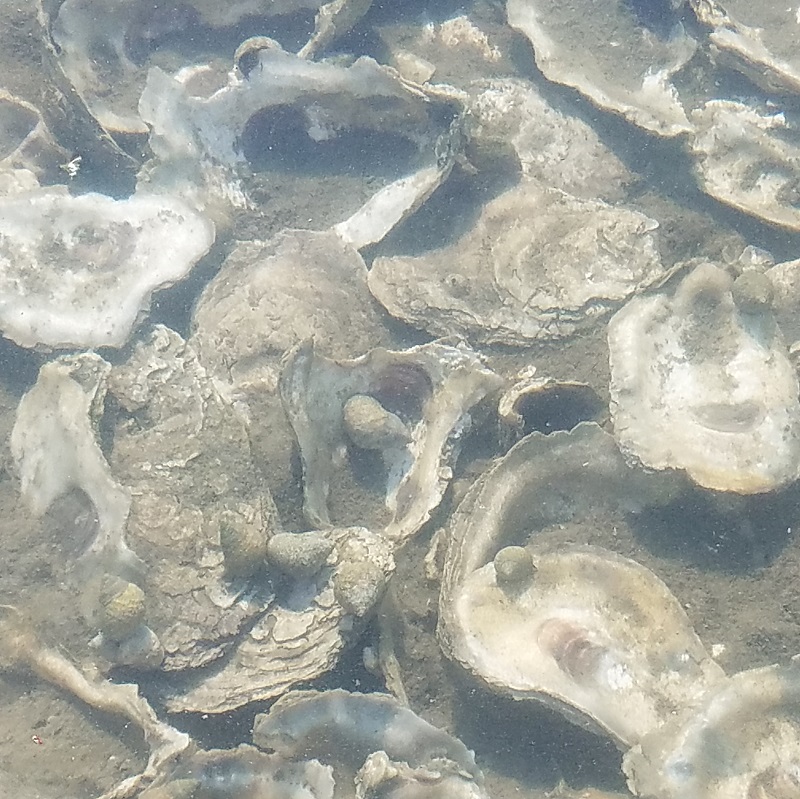
Filter-feeding bivalve that forms clusters over the bottom where conditions are suitable; mature at an early age with chain reaction spawning events by many individuals at the same time; larvae start as free-swimming, then settle onto hard surfaces free of sediment buildup; layers of large and small oysters with old shells provide surface areas for other animals to live.
|
Atlantic Ribbed Mussel (Geukensia demissa)
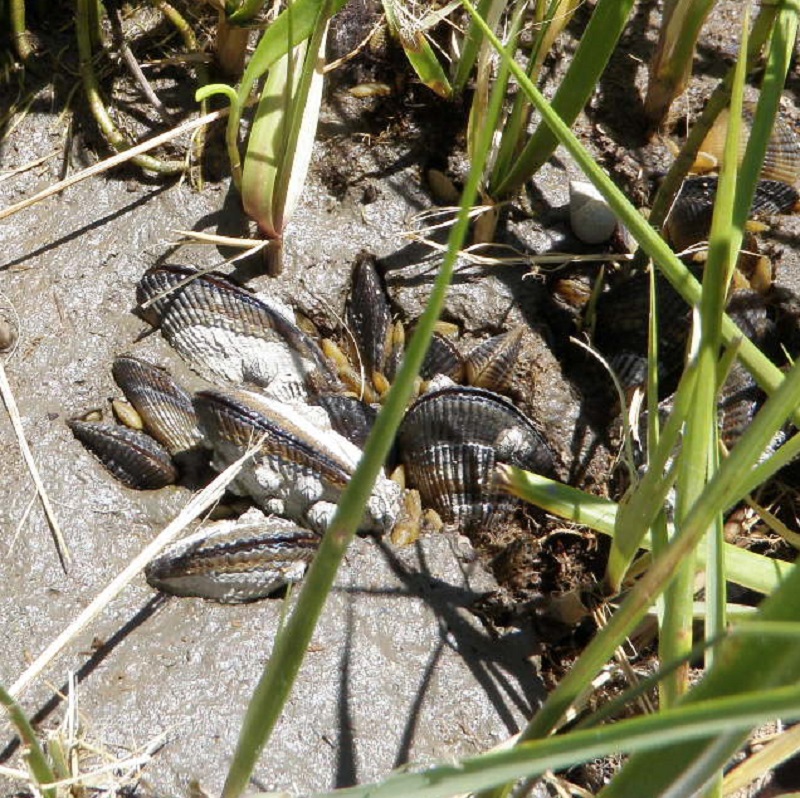
A bivalve with dark, ribbed shells; buries in the mud and aggregates among marsh plants; stimulates marsh plant root and rhizome growth with their biodeposits, and bind sediment which reduces erosion. In turn, the marsh grasses protect the mussels from heat stress and predators. Although not widely harvested by people, ribbed mussels are eaten by blue crabs, mud crabs and shorebirds.
|
Hooked Mussel (Ischadium recurvum)
Small mussel 1-2 inches long, dull-colored black or gray with shiny purple to rosy brown interior; shell is distinctly ridged and curved; attaches firmly to almost any hard surface. |
Barnacles
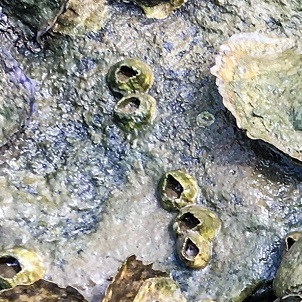
Crustaceans closely related to crabs; barnacles feed using feathery appendages that rhythmically sweep particles of food from the water column; two species in higher salinity, lower Chesapeake Bay areas are ivory barnacle (Balanus eburneus) and little gray barnacle (Chthamalus fragilis). The ivory barnacle is the largest up to 1 inch, colonies of little gray barnacles are found in the high intertidal zone and attached to marsh grasses. |
Sea Squirts (Molgula manhattensis)
Semi-transparent tunicates look like a bunch of yellowish green grapes; may grow in dense clusters attached to pilings, rocks, and empty shells; can eject or squirt large volume of water. |
Sea Anemones
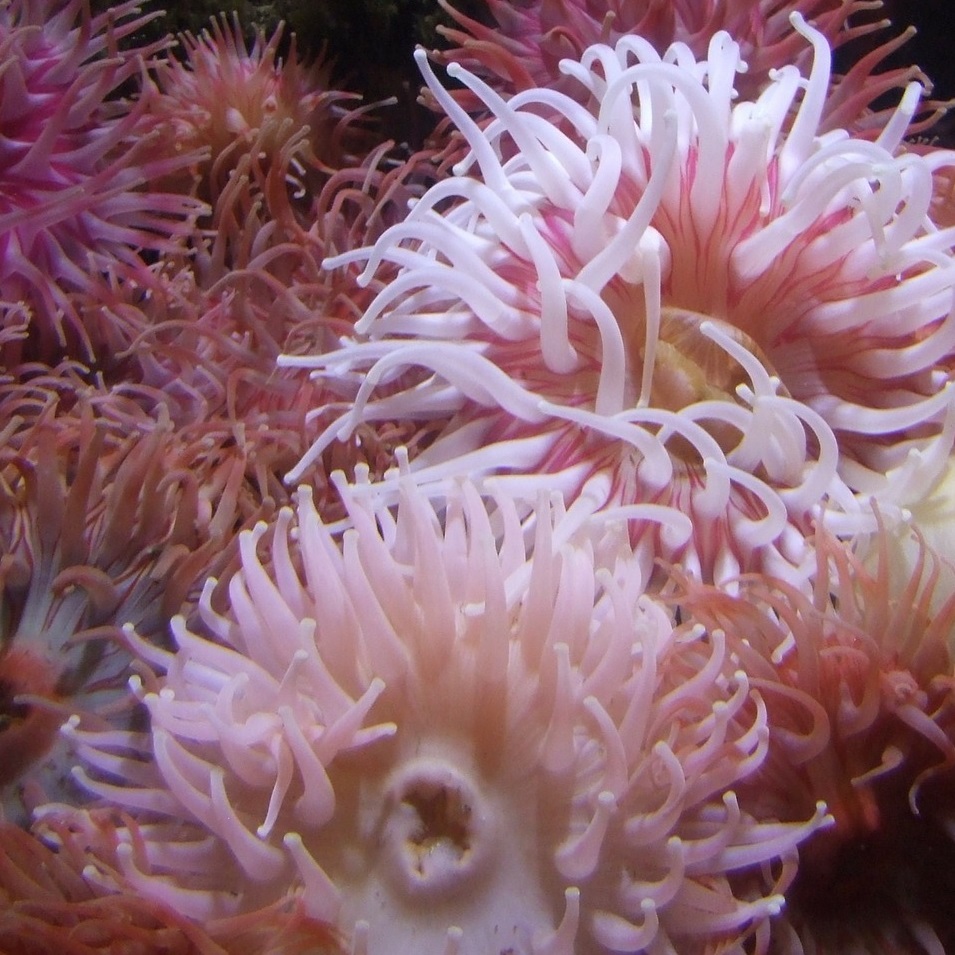
Related to sea nettles, up to 1.5 inches long with tentacles armed with stinging cells to capture prey; 2 kinds commonly found on pilings, empty shells, oysters, rocks, and plants with white or ghost anemone (Diadumene leucolena) most abundant. |
Sponges
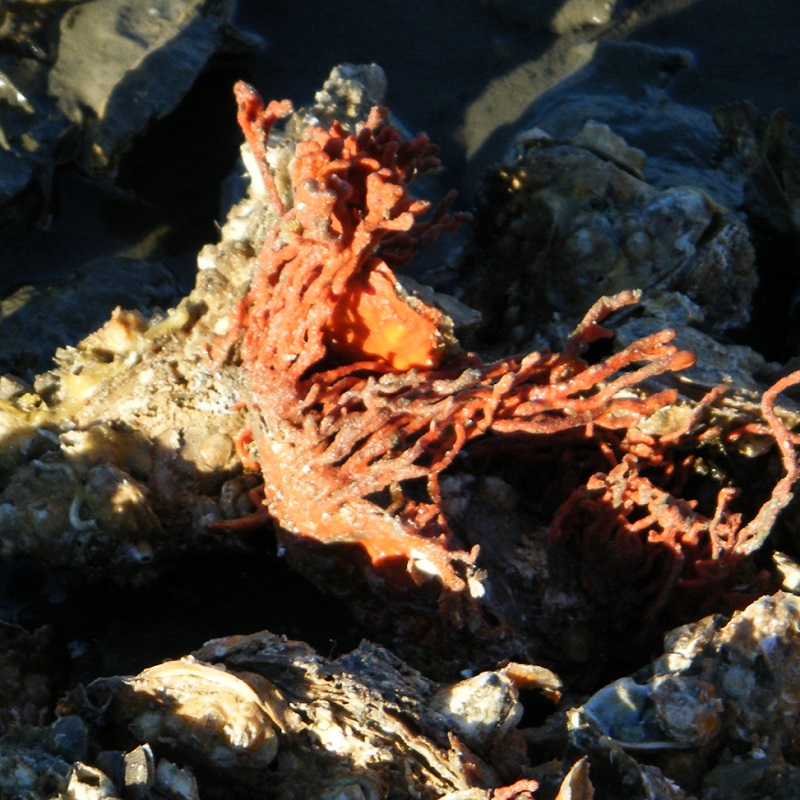
Primitive colonial animals with many microscopic individuals embedded in spongy tissues supported by tiny hard spicules that give a gritty texture; redbeard sponge (Microciona prolifera) most widespread and abundant in Chesapeake Bay; boring sponges (Cliona spp.) encrust and grow through oyster shells; folds and cavities in sponges provide refuge for small shrimp, worms, crabs and fishes. |
Tube-Building Worms
Several worm species occur in oyster reef community; whip mud worm (soft mud tubes on top of oyster shells), oyster mud worm (tubes on the inside edge of oyster shells), sandbuilder worm (sand grain tubes in well-cemented network on exterior of oysters), fan worm (small leathery tubes), limy tube worm (large, white calcareous tubes). |
Common Clamworm (Neanthis succinea)
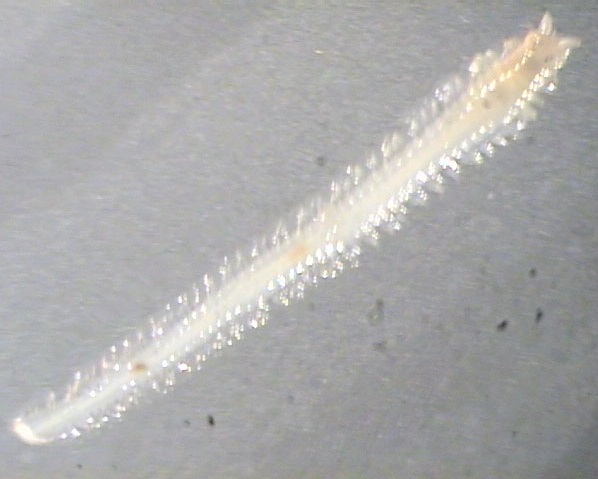
Free-swimming soft, segmented worm found in oyster reefs, mud flats and shallow waters; looks like a cross between an earthworm and a centipede; feeds on other worms and algae; important food source for bottom-feeding fish and crustaceans. |
Atlantic Oyster Drill (Urosalpinx cinerea)
Small, grayish snail with a pointed spire and knobby, ribbed shell; preys directly on oysters and barnacles by drilling pinholes through the shells. |
Marsh Periwinkle (Littoria irrorata)
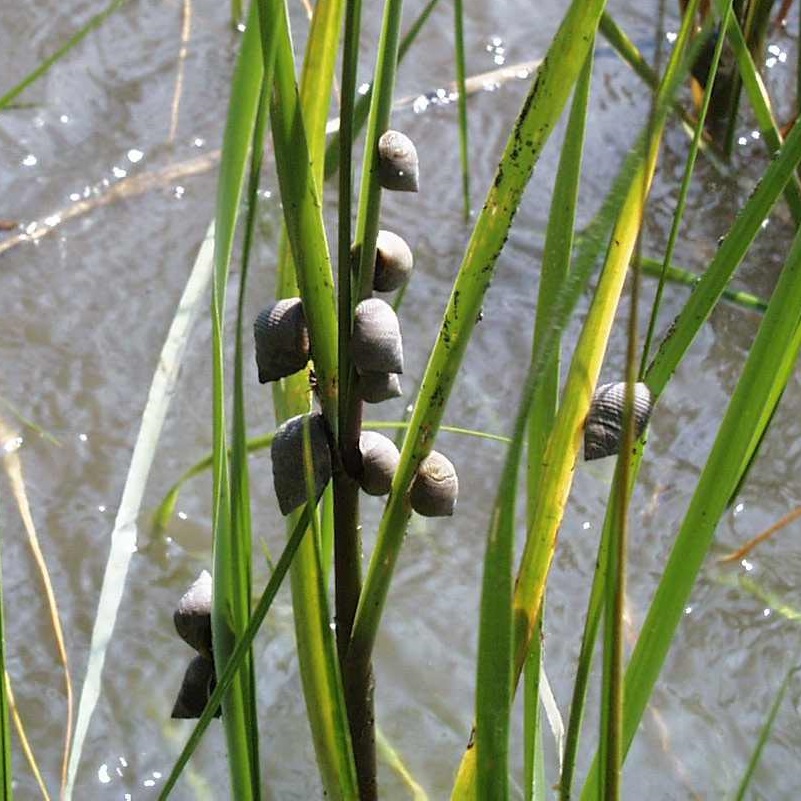
Heavy, thick-shelled snail about 1 inch long grayish white to tan with minute dashes of reddish brown on spiral ridges; abundant and conspicuous on grass stems during high tide in salt marshes protected from heavy wave action; feed on algae, detritus and bacteria on plant stems and mud surface; an operculum acts like a trap door sealing against desiccation and extreme weather. |
Skeleton Shrimp (Caprella spp.)
Skinny, sticklike amphipod with hooked rear legs that attach to sponges, seaweeds, and other epifauna on the sediment surface; moves along like an inchworm. |
Mud Crabs
Small, brown crabs in the crevices of oyster shells; common predators of small oysters, barnacles, mussels; five species occur in Chesapeake Bay including white-fingered mud crab, flat mud crab, black-fingered mud crab, equal-clawed mud crab, grooved-wristed mud crab. |
Oyster Crab (Pinnotheres ostreum)
Small crabs that live within oysters as adults attached to the oyster’s gills; about the size of a pea so they are commonly called pea crabs; soft, pale shells and poorly developed legs because they live protected inside oysters. |
Hermit Crabs (Pagurus spp.)
Entire life spent inside snail shells except free-swimming larval stages; feed on anything available such as organic matter, algae, and dead animals; three species common from Tangier Sound to the Chesapeake Bay mouth including banded hermit crab (Pagurus annulipes), long-clawed hermit crab (Pagurus longicarpus), broad-clawed hermit crab (Pagurus pollicaris). |
Fiddler Crabs (Uca spp.)
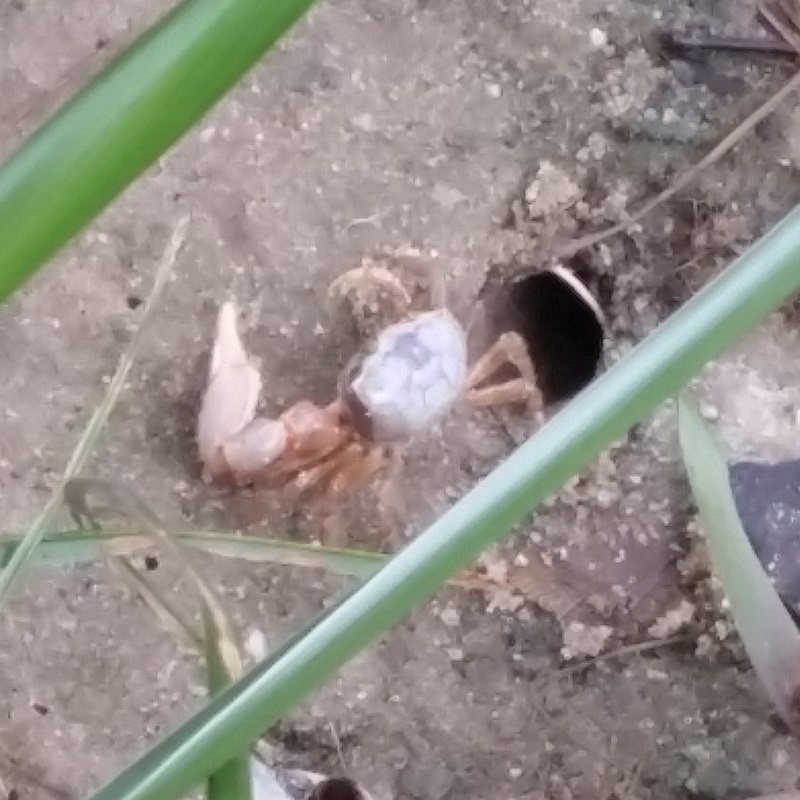
Males have one large claw for defense and to attract a mate; move onto mud flats at low tide to feed on algae and decaying marsh plants; live in burrows with plugged entrances for protection from predators and weather; three species in Chesapeake Bay mud flats and salt marshes, including the mud fiddler crab (Uca pugnax), red-jointed fiddler crab (Uca minax), and the less common sand fiddler (Uca pugilator). |
Oyster Toadfish (Opsanus tau)
Bottom-dwelling fish up to 1 foot long with wide-gaping jaws armed with sharp teeth; sharp spines on dorsal fin; omnivorous feeders that eats small crabs, mollusks, and small fish; makes distinct sounds including foghorn calls during mating and loud grunts to express annoyance or fear; males guard eggs and young fry in dark, secluded places, including oyster reef crevices, rocks, old cans and bottles. |
Gobies
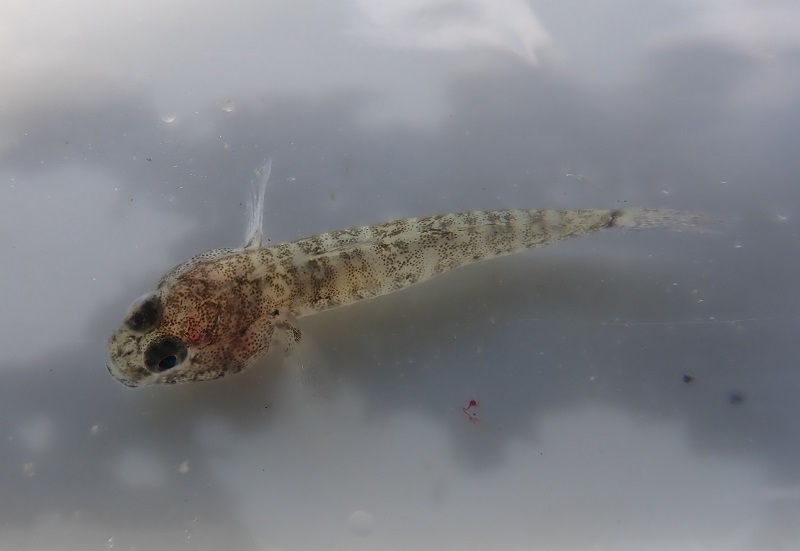
Small, secretive fish up to 2 inches long; abundant but with solitary habit; prominent eyes set close together on top of head; males guard eggs laid inside of dead oyster shells; feed on worms and small crustaceans; three species common in Chesapeake Bay include naked goby (Gobiosoma bosci), seaboard goby (Gobiosoma ginsburgi) and the green goby (Microgobius thalassinus). |
Blennies
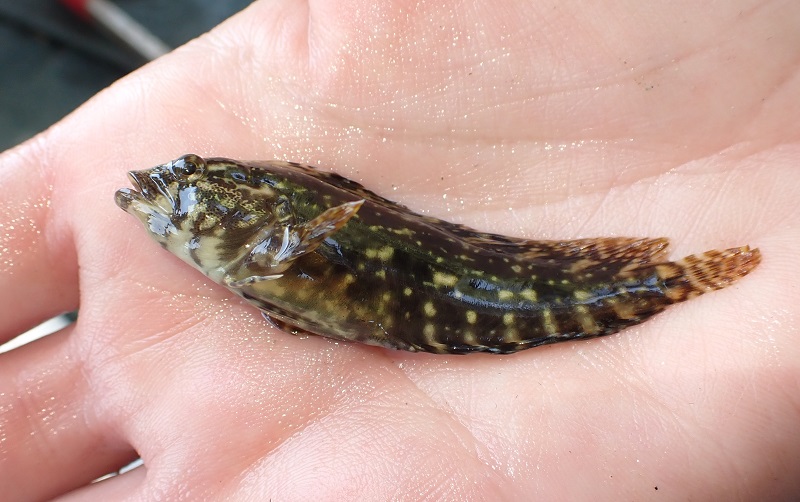
Similar to Gobies in size and behavior except more brightly colored; striped blenny (Chasmodes bosquianus) and feather blenny (Hypsoblennius hentz) occur in Chesapeake Bay; feed on small mollusks and crustaceans; males aggressively guard eggs laid inside empty oyster shells. |
Skilletfish (Gobiesox strumosus)
Small frying pan-shaped body up to about 3 inches in length; also called oyster cling-fish with a large suction disk on the underside of the body used to cling to oyster shells or rocks; evenly speckled with brown provides camouflage in oyster reef habitat. |
 The Oyster Reef and Benthic Community includes animals that live on or under the mud flat area of the salt marsh. A small-scale oyster reef is covered during high tides and exposed at low tides. Oyster reefs provide vertical hard surfaces and spaces for attachment and shelter. Many animals live on and around oyster reefs. Some are firmly attached while others crawl or swim between the oysters, shells and other attached organisms. Healthy, living oyster reef communities also provide shoreline protection, nutrient cycling and water quality improvement.
The Oyster Reef and Benthic Community includes animals that live on or under the mud flat area of the salt marsh. A small-scale oyster reef is covered during high tides and exposed at low tides. Oyster reefs provide vertical hard surfaces and spaces for attachment and shelter. Many animals live on and around oyster reefs. Some are firmly attached while others crawl or swim between the oysters, shells and other attached organisms. Healthy, living oyster reef communities also provide shoreline protection, nutrient cycling and water quality improvement.










